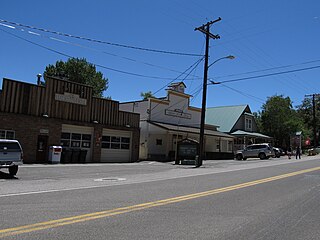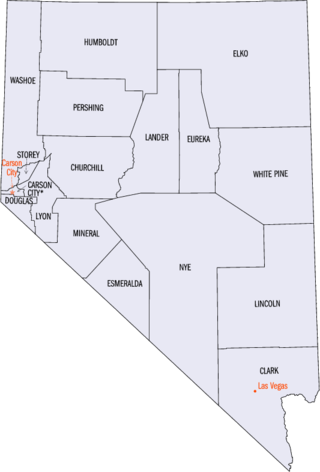
Genoa is an unincorporated town in Douglas County, Nevada, United States. Founded in 1851, it was the first settlement in what became the Nevada Territory. It is situated within Carson River Valley and is approximately 42 miles (68 km) south of Reno. The population was 939 at the 2010 census. It is home to the oldest bar in the state of Nevada which opened in 1853.

This is a list of properties and historic districts in Arkansas that are listed on the National Register of Historic Places. There are more than 2,600 listings in the state, including at least 8 listings in each of Arkansas's 75 counties.

This is a list of properties and historic districts in Nevada that are listed on the National Register of Historic Places. There is at least one listing in each of Nevada's 16 counties and one independent city.
Mormon Well Spring is located in the Desert National Wildlife Range and was used from around 1900–1924 for ranching. It is listed on the United States National Register of Historic Places. Nearby is Corn Creek Campsite, another listed historic place.

Corn Creek Campsite is located in the Desert National Wildlife Range and was used from around 1900–1924 for ranching and is listed on the United States National Register of Historic Places. Nearby is Mormon Well Spring another listed historic place.

The Hidden Forest Cabin is an old game warden's dwelling in Clark County, Nevada, United States in the Desert National Wildlife Refuge. It is located on Hidden Forest Road, in the Hidden Forest in the Sheep Range along the route to Hayford Peak.
Tule Springs Archaeological Site is an archeological site listed on the National Register of Historic Places that is located in the Las Vegas Valley of Nevada, United States. It is one of a few sites in the United States where humans were once thought to have lived alongside, and potentially hunted, extinct Ice Age megafauna, although this view is not supported by the available scientific data and is no longer generally accepted.

Goldfield Historic District is a historic district located in the center of Goldfield, Esmeralda County, Nevada, United States.

The Carolina Methodist Church is a historic church in rural Nevada County, Arkansas, United States, about 5 miles (8.0 km) east of Rosston, that is listed on the National Register of Historic Places.
The Wieland Brewery Building is a historic building located on Mineral Street in Tonopah, Nevada. Built in 1901, the building was the first stone building constructed in Tonopah. It was also one of the first permanent buildings built in the town, which was still primarily a mining camp at the time. The building had several owners in its early years. It was apparently first owned by H.C. Brougher, but businessman Harry King bought the brewery by the end of 1901. King sold the brewery to two other businessmen in the spring 1902 but purchased it again by the following October. At the end of 1902, King added a crafted parapet to the building, which indicates that Tonopah had local stone craftsmen by that time.
Tybo is an unincorporated community in Nye County, Nevada, United States. Tybo is 8 miles (13 km) northwest of U.S. Route 6 and 10 miles (16 km) northeast of Warm Springs. The community was established in the 1870s as a silver mining town. Its name came from the Shoshone word tybbabo or tai-vu, meaning "white man's district". The community prospered in the 1870s; its population neared 1000, and it had a school, post office, and newspaper by the end of the decade. A variant is Tyboe found on Wheeler's map of 1871.
The James Wild Horse Trap in Nye County, Nevada, near Fish Springs, is a historic site that is listed on the U.S. National Register of Historic Places. It was the location of a corral and fences used to capture wild horses, built out of dead Juniper trees. It is as described in a book by Will James, Sand, or Lone Cowboy, published by Charles Scribner's Sons in 1930.

The Sand Springs Station is a historic site in Churchill County, Nevada that was listed on the National Register of Historic Places in 1980. A Pony Express station existed there in 1860. The ruins are located within the boundaries of the Sand Mountain Recreation Area.

The Cal-Vada Lodge Hotel is a historic hotel in Crystal Bay, Nevada, United States, at the California-Nevada border at the north end of Lake Tahoe, is a Bungalow/craftsman-style hotel that was built in 1935. It was listed on the National Register of Historic Places in 1994.

The Cold Springs Station Site, west of Austin, Nevada, is a historic stagecoach station site that was active during 1861-1869 as a passenger and freight station, and later for freight. Only stone ruins remain. Nearby is the location of the original Cold Springs Pony Express Station Ruins.
Russell Mills (1892-1959) was an American architect based in Reno, Nevada. A number of his works are listed on the U.S. National Register of Historic Places. He "spent early years" in the Philippines. He worked as a draftsman for noted architect Frederic DeLongchamps.

The Veterans Memorial Elementary School, also known as Veterans Memorial STEM Academy, at 1200 Locust St., is a public elementary school in Reno, Nevada, operated by the Washoe County School District. It occupies a historic Moderne-style building dating from 1949 that was designed by Nevada architect Russell Mills. It was listed on the National Register of Historic Places in 1995. It was deemed significant "for its role in the local history of education" and "for its Art Deco/Moderne style of architecture by a prominent local architect, Russell Mills."

The Carson Brewing Company, at 102 S. Division St. in Carson City, Nevada, was built in 1864. Also known as the Carson City Nevada Appeal Building, it was listed on the National Register of Historic Places in 1978. It was originally a brewery and bar.

University of Nevada Reno Historic District on the campus of the University of Nevada, Reno is a 40-acre (16 ha) historic district that was listed on the National Register of Historic Places (NRHP) on February 25, 1987. It includes works by architects Stanford White and Frederick J. DeLongchamps. It includes 13 contributing buildings and two other contributing structures, including two separately NRHP-listed buildings, the Mackay School of Mines Building and Morrill Hall. The 13 historic buildings are:

Morrill Hall at the University of Nevada, Reno is a historic Italianate building that was built during 1885–86. It was described by architect Edward Parsons as "'a classic example of Italianate Victorian architecture...dignified with a wood shingled mansard roof and full dormer windows.'"













